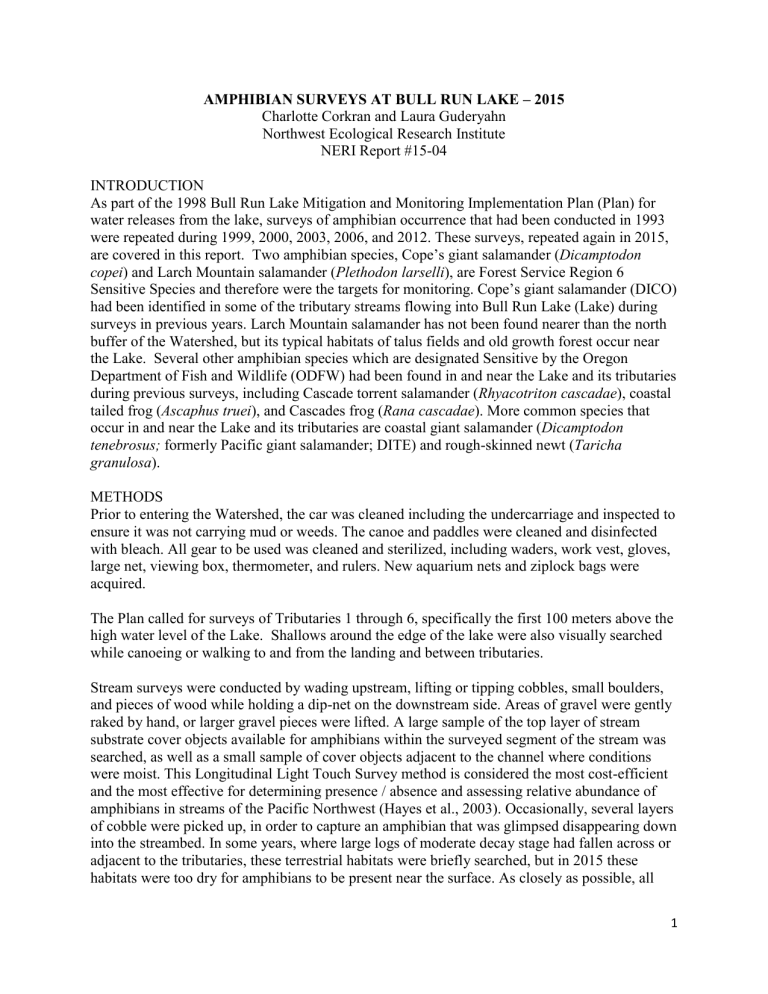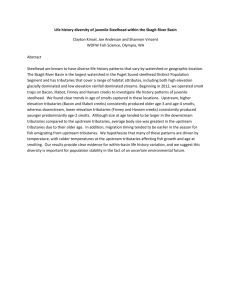15-04 Amphibian Surveys at Bull Run Lake 2015

AMPHIBIAN SURVEYS AT BULL RUN LAKE – 2015
Charlotte Corkran and Laura Guderyahn
Northwest Ecological Research Institute
NERI Report #15-04
INTRODUCTION
As part of the 1998 Bull Run Lake Mitigation and Monitoring Implementation Plan (Plan) for water releases from the lake, surveys of amphibian occurrence that had been conducted in 1993 were repeated during 1999, 2000, 2003, 2006, and 2012. These surveys, repeated again in 2015, are covered in this report. Two amphibian species, Cope’s giant salamander (
Dicamptodon copei ) and Larch Mountain salamander ( Plethodon larselli ), are Forest Service Region 6
Sensitive Species and therefore were the targets for monitoring. Cope’s giant salamander (DICO) had been identified in some of the tributary streams flowing into Bull Run Lake (Lake) during surveys in previous years. Larch Mountain salamander has not been found nearer than the north buffer of the Watershed, but its typical habitats of talus fields and old growth forest occur near the Lake. Several other amphibian species which are designated Sensitive by the Oregon
Department of Fish and Wildlife (ODFW) had been found in and near the Lake and its tributaries during previous surveys, including Cascade torrent salamander ( Rhyacotriton cascadae ), coastal tailed frog ( Ascaphus truei ), and Cascades frog ( Rana cascadae ). More common species that occur in and near the Lake and its tributaries are coastal giant salamander ( Dicamptodon tenebrosus; formerly Pacific giant salamander; DITE) and rough-skinned newt ( Taricha granulosa ).
METHODS
Prior to entering the Watershed, the car was cleaned including the undercarriage and inspected to ensure it was not carrying mud or weeds. The canoe and paddles were cleaned and disinfected with bleach. All gear to be used was cleaned and sterilized, including waders, work vest, gloves, large net, viewing box, thermometer, and rulers. New aquarium nets and ziplock bags were acquired.
The Plan called for surveys of Tributaries 1 through 6, specifically the first 100 meters above the high water level of the Lake. Shallows around the edge of the lake were also visually searched while canoeing or walking to and from the landing and between tributaries.
Stream surveys were conducted by wading upstream, lifting or tipping cobbles, small boulders, and pieces of wood while holding a dip-net on the downstream side. Areas of gravel were gently raked by hand, or larger gravel pieces were lifted. A large sample of the top layer of stream substrate cover objects available for amphibians within the surveyed segment of the stream was searched, as well as a small sample of cover objects adjacent to the channel where conditions were moist. This Longitudinal Light Touch Survey method is considered the most cost-efficient and the most effective for determining presence / absence and assessing relative abundance of amphibians in streams of the Pacific Northwest (Hayes et al., 2003). Occasionally, several layers of cobble were picked up, in order to capture an amphibian that was glimpsed disappearing down into the streambed. In some years, where large logs of moderate decay stage had fallen across or adjacent to the tributaries, these terrestrial habitats were briefly searched, but in 2015 these habitats were too dry for amphibians to be present near the surface. As closely as possible, all
1
cover objects were returned to their original positions in or adjacent to the stream, and all amphibians, fish, and invertebrates captured were released on the upstream side of the cover object they were using. Amphibians captured along the shoreline of the Lake were released at the point of capture.
Several methods were used to make the notoriously difficult distinction between DICO and the more common DITE. In order of weight given in the differentiation, these were: head width and length in proportion to body length, leg length in proportion to body length, development of granular glands on the dorsal surface, ventral coloration, gill filament length, and dorsal tail fin length and height (as in Corkran and Thoms, 1996, and Jones, et al., 2005). Snout-to-vent length measurements were taken of several individual Dicamptodons, and estimates were made for others captured or observed.
No terrestrial surveys specifically targeted for Larch Mtn. salamander have been conducted near the Lake, which is within the elevation range but outside the known geographic range of the species. The Plan specifies surveys of the Tributaries only, whereas habitat for Larch Mtn. salamander is talus and upland forest. It is unlikely that releases from the Lake could have any effect on Larch Mtn. salamanders if they did occur in adjacent upland habitats.
Water temperature was recorded in most of the tributaries. Observations of trout and general abundance of macro-invertebrates in the tributaries were also recorded during the surveys.
All amphibian data from the surveys have been entered into a database and will be reported to both the Mt. Hood National Forest and ODFW (Scientific Taking Permit #024-15) at the end of the calendar year.
RESULTS
On September 21, 2015, Charlotte Corkran and Laura Guderyahn surveyed approximately 100 meters of Tributaries 4A, 4B, 5, and 6 while canoeing around the Lake. On October 5 we walked along the north shoreline and surveyed Tributaries 1, 2, and 3 as well as an additional stream between 2 and 3. After completing the surveys of these Tributaries, we spent a few minutes surveying the Lower Springs of the Bull Run River (not included in the figure or tables). No terrestrial salamander surveys were conducted around the Lake because conditions were too dry, although brief searching in wet terrestrial habitats immediately adjacent to the tributaries was included in the stream surveys. We did not conduct any surveys during the year of the areas behind the dike or below the outlet, or of any talus or forested habitats near the Lake.
Figure 1 shows the approximate location of all Lake tributaries surveyed. Because of the dry summer the Lake level was quite low, as were all tributaries. This made finding several streams challenging, because the water flowed sub-surface at the mouth. Flagging, presumably from the most recent fish surveys, was present only at Tributaries 4B, 5, and 6, and could not be used to confirm the identity of other streams. Hence we also surveyed an additional stream northwest of
3 and are not certain we surveyed the correct Tributary 4A. Tributary 1 was totally dry, and
Tributary 2 only ran at the surface for about 2 meters.
2
Table 1 shows the amphibian species found at every surveyed area around the Lake, and includes the numbers of each species found in each year of surveys since 1993. We observed a total of 79 amphibians during the stream surveys this year. Only a very few of the Dicamptodons eluded complete capture, but these were seen briefly. No DICO were identified during the surveys in
2015 in any of the Tributaries of the Lake. However, one dead DICO larva was found at the
Lower Springs of the Bull Run River. The 43 DITE larvae found ranged in size from 25 to 92 mm snout-to-vent length (SVL), all immature individuals. No metamorphosed Dicamptodons were observed. All of the Cascade torrent salamanders were large larvae and adults. The coastal tailed frogs were larvae showing no sign of legs yet, but one adult was also found. One roughskinned newt was seen in the extra stream and one in the Lake. Cascades Frog juveniles were observed at the mouths of Tributaries 5 & 6 and one in Tributary 4B.
Stream temperatures recorded were between 9.5 and 10.5° C. The average for all of the streams was 9.9° C, which was slightly higher than the average temperature recorded in any previous surveys of these tributaries (Table 2). In the Lower Springs of the Bull Run River, the water temperature was 8.5° C.
A few trout were observed in all tributaries except 1 and 2. All were juveniles roughly 25 to 40 mm total length. Very few macro-invertebrates were seen in any of the tributaries.
DISCUSSION
Numbers of most amphibian species observed in the 2015 surveys were similar to those found in previous years, with a few exceptions. The great increase in the number of DITE, the highest number found in any year, may reflect the fact that two people simultaneously conducted the surveys (with John Deshler as an additional back-up), as well as the fact that with stream levels so low, amphibians were confined to a smaller area of the substrate for us to survey. The apparently precipitous decline of rough-skinned newts in the Lake simply reflects the time of year of the Tributary surveys, which in recent years do not include data from other visits to the
Lake shore, when numerous individuals are commonly seen every year.
The significant difference between results of the surveys in 2015 and previous years is that, for the first time, no DICO were identified. This could possibly indicate a real population decline. If global climate change had raised the stream temperatures, or if water quality or quantity had been reduced, it is possible that the more adaptable DITE could flourish while DICO died out.
The drought conditions that have kept Tributaries 1 and 2 dry or with only subsurface flow in recent years could have allowed DITE to outcompete or otherwise displace the smaller DICO.
However, the temperatures recorded were only very slightly higher than in previous years.
Furthermore, the torrent salamanders are known to be more sensitive to temperature increases, but they were present in normal numbers. Finding a single dead DICO at the Lower Springs is not likely to be of any significance because we also found several live Cascade torrent salamanders in the same stream reach.
A second possible explanation for the lack of DICO is that conducting the surveys later in the season in recent years (September and October rather than June to August) could have missed the window when DICO were active at the surface of the substrate. However, there are no published reports to indicate this. In fact DICO are known to breed in the fall.
3
A third possible explanation is that DICO and DITE are interbreeding in the tributaries of the
Lake, and the confusing individuals are hybrid offspring. However, although the ranges of these species overlap in the Columbia River Gorge and elsewhere, there are no published reports of hybridization occurring anywhere.
The lack of DICO identified this year, and the apparent decline over several recent surveys, more probably reflect an increasingly conservative approach on Corkran’s part to identifying this species. Starting in 1993, in identifying these two closely related species, I probably gave nearly equal weight to all of the distinguishing features. More recently, I have found that DITE are more plastic in several of their attributes then I originally thought. Some individual DITE resemble DICO’s supposedly diagnostic dark ventral coloring and small gill filament length, and have more slender overall proportions than is typical for the species. In the surveys in previous years, when an individual Dicamptodon was seen but not actually caught and observed closely, if
I noted these DICO-like features, I probably identified it incorrectly. By now, when distinguishing between DICO and DITE, I give much greater weight to the proportional head, leg, and body lengths. Because we were able to capture all but a very few of the Dicamptodons observed this year, we were therefore able to visually measure the body proportions of almost all individuals found. It is embarrassing to admit the probability of being incorrect in previous reports, and the possibility that DICO never has occurred in the tributaries of the Lake.
Unfortunately I have no photos from early years of the surveys of these tributaries to examine now.
Subsequent surveys of the Lake tributaries should be conducted between mid-August and mid-
October for optimal conditions to observe (if not always to capture) the maximum number of individuals, particularly of the target species, DICO. Perhaps in a less dry summer or towards the earlier end of that time period individuals of that species would be found and could be documented with photographs. It would be helpful either to place permanent markers at the mouths of the seven tributaries, or to make sure that correct GPS coordinates are available to the surveyors.
CITATIONS
Corkran, C. C. and C. Thoms. 1996 (Revised edition 2006). Amphibians of Oregon, Washington and British Columbia: A Field Identification Guide . Lone Pine Publishing, Edmonton,
Alberta.
Hayes, M. P., D. J. Dugger, T. L. Hicks, and T. Quinn. 2003. Comparing amphibian sampling methods: Which is best for headwater streams? Joint Conference of Society for
Northwestern Vertebrate Biology and California North Coast Chapter of The Wildlife
Society, Arcata, CA, Mar. 19-22, 2003.
Jones, L. L. C., W. P. Leonard, and D. H. Olson, eds. 2005. Amphibians of the Pacific
Northwest . Seattle Audubon Society, Seattle, WA.
4
5
T4A-‘93
‘99
‘00
‘03
‘06
2012
2015
T4B –93
‘99
‘00
‘03
‘06
2012
2015
Table 1. Amphibian surveys in the Bull Run Lake area, 1993 to 2015. AMGR = northwestern salamander, TAGR = rough-skinned newt, DICO = Cope’s giant salamander, DITE = coastal giant salamander, m = metamorphosed adult, RHCA = Cascade torrent salamander, ASTR = coastal tailed frog, RACAS = Cascades frog. T1,...T6 = Tributary number, Lk = Lake edge.
SITE -
YEAR
AMGR TAGR DICO* DITE* RHCA ASTR RACAS
T1 – ‘99
‘03
3 6
‘06
2012
2015
T2 – ‘93
‘99
‘00
‘03
‘06
2012
2015
1
4
1
4
1
1
3
3
1
5
1
2
1
1
1
1
6
3
2
5
5 [Extra trib.
NW of 3] –
2015
T3 – ‘93
‘99
‘03
‘06
2012
2015
2 1
1
1
4
11
4
1
1 m
1
4
2
1
4
3
5
1
13
4
10
3
1, 1 m
1, 1 m
7
1
13
3
1
1
1
1
5
2
1
3
4
13
6
7
3
1
1
1
6
7
Table 2. Stream temperatures (Celcius)
1993 1999
Survey
Dates
Jun. 17 Aug. 17
Tributary #
1
2 wrong trib.
3
--
7.2
--
--
9
--
--
8
4A
4B
5
6
Average for all tributaries
6
6.7
9
6
7
9
--
10
10
9
2000
Jun. 28
9
8
--
--
8
10
9
7.5
8.5
2003
Sep. 30 /
Oct. 1
--
--
9
8
8
9
--
9
8.5
2006
Oct. 20
6
6
--
6
6
6.5
5
5
5.8
2012 2015
Sep. 26 Sep. 21 /
Oct. 5
9 --
8.5
--
8.5
8.5
8.5
8.5
7.8
--
9.7
9.5
9.7
--
10
10.5
8.5 9.9
8









